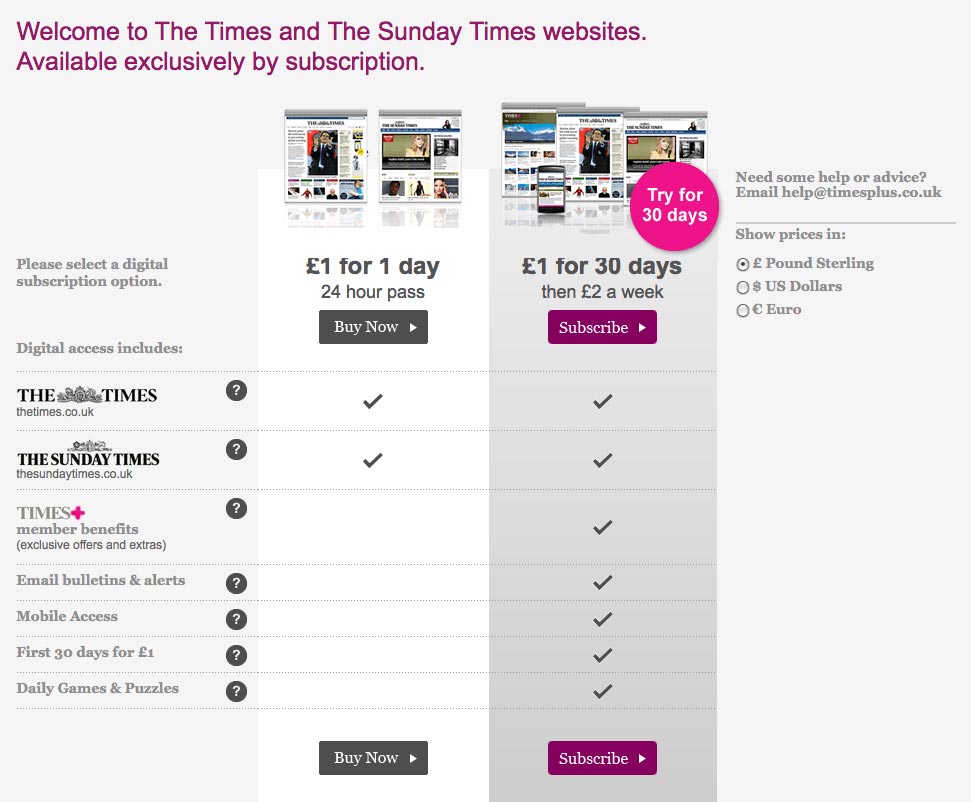Having had a day to “browse and snack” on the new Sunday Times and Times websites, what’s the feedback so far? What’s the reaction to the new editorial layout, multimedia changes and approach to journalism behind a paywall?
Starting with those bloggers who were given a sneak preview of the sites the night before they went live:
Malcolm Coles on the Times:
Without the need to chase search engine traffic or page views for advertisers, the idea of covering fewer stories but in a better way sounds appealing (…) an article, for instance, with an information graphic and tabs to let you explore the history and different aspects of the story without leaving the page. This package of content is brilliant – it works much better as an experience than lists of related articles or auto-generated tag pages.
But, asks Coles, shouldn’t readers be allowed to subscribe to just one site with completely distinct sections and topics?
It strikes me that there is either sufficient distinction in the audience for the two brands that you let users subscribe to just one site; or the audiences cross over so much that you combine the two sites in one and think about what makes most sense from the user’s point of view.
Forcing people to subscribe to both sites but keeping them entirely separate, with no cross-linking, seems a bit odd.
Adam Westbrook on the experience of reading the Times and Sunday Times online:
Well, at first impressions I am not bowled over: black text on a white screen, size 12, serif font – just like every other news website out there (and even this blog!). A web page can be any colour and fully dynamic – a concept no major newsroom is yet to grasp.
Rory Cellan-Jones on how a smaller audience might offer a more engaged readership:
[T]he company is convinced that advertisers will find the smaller audience of committed readers more attractive than the 21 million promiscuous passers-by who flit through the free Times Online site each month at present. While there’s been plenty of sniping from the sidelines by News International’s rivals, I suspect they are all glad that someone is at least testing the waters.
Tim Fenton:
It’s a slick package, although whether well-bundled, good content is enough of a differentiator from everything on Google News remains to be seen. For me, the biggest surprise is that the Times is not planning a splashy ad campaign to launch the paywall – it is relying chiefly on promotion in the newspaper.
It’s a low-key – and very analogue – start to one of the biggest experiments in modern digital media.
Of those reviewing the sites today, TechCrunch Europe expands on concerns raised that the papers’ journalists will miss out on social media conversation around their work, with thoughts on what the paywall means for mobile and ecommerce developments:
I don’t know The Times’ development roadmap, but if it does not have an API for its content (I presume it won’t since the whole of the new sites will be paywalled and invisible to search engines) then there will be no opportunity to catch the Third Wave of social or indeed of mobile or commerce. The Times cannot possibly come up with all the ideas which will happen in the Third Wave, which is why third-party developers will be so important.
Will the Times and Sunday Times be taking themselves out of the social media conversation with paywalls that redirect deep links to a generic login page? (Interesting to note findings from a Pew Research Center study, which report that bloggers will share more links and stories produced by mainstream news organisations, Twitterers less so, suggesting there’s is still a reliance of the social media news world on traditional news outlets. Interesting also – digital director of Mirror Group Matt Kelly’s remarks last week about the importance of honing news sites to niches that their readers identify as the values of that particular paper or brand.)
Adam Tinworth provides food for thought on the issue with his post on the potential impact of a subscription wall on a site’s community:
People sharing what they think will be identifiable, and they will have paid an entrance fee to get in there. This is, in fact, a community model, just one that differs from the wide, inter-connected community model we’re used to on the open web.
I recall Lee Bryant saying at last year’s Social Media Influence conference that sometimes its the wall that defines the community. And that maxim will be tested on these sites.
